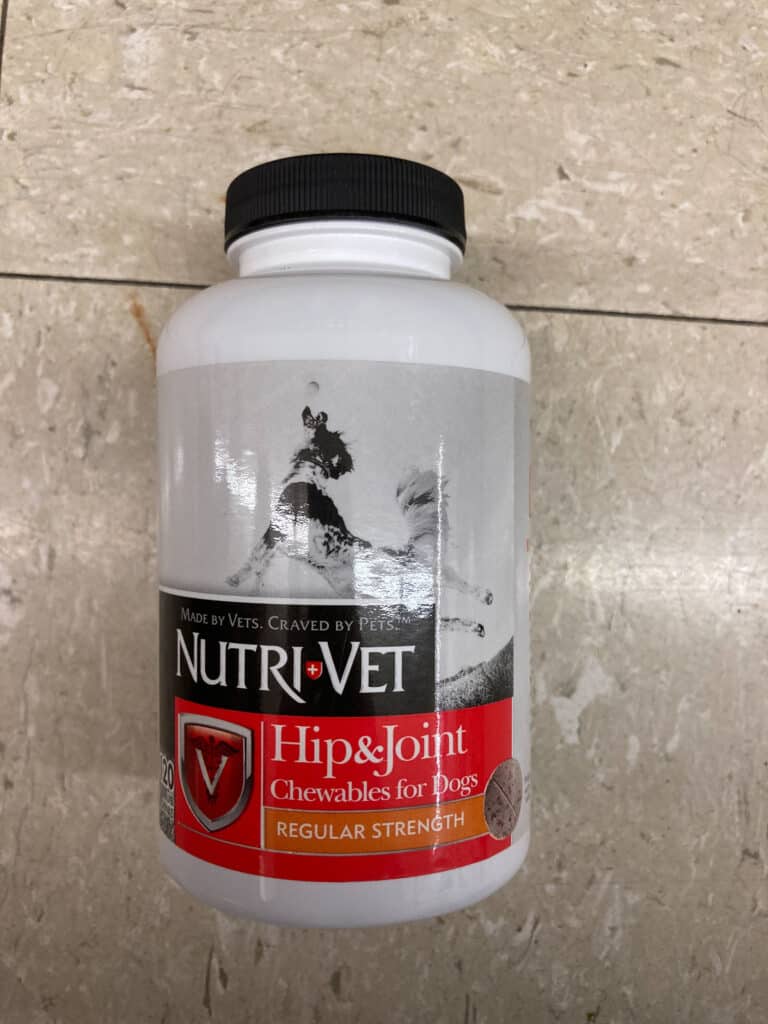Aging is a part of every dog’s life cycle. Some may get older with very few aches and pains, while others can develop diseases like osteoarthritis, a slowly progressing and debilitating condition. Over 20% of the canine population over one suffers from osteoarthritis, which can significantly impact your pup’s quality of life. Vets often recommend glucosamine as a natural way to treat osteoarthritis. Discover the benefits, side effects, and suggested dosage for hip and joint health.
What is Glucosamine?

©A-Z-Animals.com
Glucosamine is a naturally occurring compound in the body. It regulates the synthesis of collagen in cartilage and provides anti-inflammatory effects. Collagen is found in connective tissue, like cartilage, bones, tendons, ligaments, and skin. Essentially, glucosamine directly affects how collagen is made—taking glucosamine benefits those suffering from a loss of cartilage and bone.
Typically, dogs suffering from degenerative joint diseases are prescribed Non-steroidal anti-inflammatory drugs (NSAIDs). But these drugs can cause painful ulcers and other adverse side effects. Glucosamine is used as a more natural treatment and may be combined with chondroitin sulfate, another natural compound that inhibits destructive enzymes in joint fluid and cartilage. You can find these compounds in supplement form at most pet stores.
How Do I Know if My Dog Needs Glucosamine?

©NayaDadara/Shutterstock.com
Look for these signs to determine if your dog needs glucosamine for hip and joint health:
- Stiffness or limping, especially in the morning or during cold weather
- Slow to stand or sit down
- Reluctant to climb on couches, beds, or get in the car
- Avoids walking up or down stairs
- Excessive panting can be a sign of pain
- Uninterested in playing or going for walks
- Joint swelling. Areas may be larger, and painful to touch.
What is the Best Glucosamine For Dogs?
The best glucosamine supplement will come from a veterinarian’s recommendation. The dog supplement industry is popular with corporations, and they like to put the words “hip and joint health” on many products. But not all are created equal. It’s best to speak with a professional about the best products so that you know you’re getting what you pay for.
Can I Give Human Glucosamine to My Dog?
You should never give your dog human glucosamine and chondroitin supplements. Human supplements can contain extra ingredients, like artificial sweeteners, that can be toxic to dogs. It’s always best to err on the side of caution and use products specifically designed for canines.
Benefits of Glucosamine in Dogs

©LNbjors/Shutterstock.com
A vet may recommend using glucosamine in conjunction with weight loss, exercise modifications, and physical therapy. Joint supplements can provide excellent benefits that improve your dog’s overall quality of life.
Here are some other benefits of glucosamine:
- Eases discomfort
- Improves daily functions, like walking and standing
- Increases exercise tolerance
- Improves mood and behavior
- Decreases stiffness and allows for a better range of motion
- Strengthens pet-owner relationships
What Are the Side Effects of Glucosamine in Dogs
Like with any supplement, vitamin, or medication, there is always a risk of side effects. Thankfully glucosamine is considered safe and effective for dogs. The most common side effect of the supplement is an upset GI, which can cause diarrhea and gas. This typically occurs when a dog eats more than the recommended amount.
Glucosamine Dosage for Hip and Joint Health

©iStock.com/shironosov
Glucosamine often comes in the form of a flavored chew, and pet parents can give the supplement to their dogs based on the label directions. Typically, offered with their regular food or as a treat between meals. Speak with your vet about proper dosing. But most will advise a “loading dose,” where you give an increased amount for the first several weeks before leveling the dosage out to a more suitable quantity.
How Quickly Does Glucosamine Work in Dogs?
Glucosamine supplements are not an immediate fix for joint pain. They are to be used as a long-term health routine. Your dog typically won’t see the full benefits for at least two months of consistent usage. If you believe the supplement is not working, try taking your dog off of his regular dosage after two months and see if his condition worsens or stays the same.
*Note: AZ Animals does not attempt to give medical or veterinarian advice. Speak with a licensed professional before giving your dog new supplements and medication, or discontinuing medication.
Up Next:
Ready to discover the top 10 cutest dog breeds in the entire world?
How about the fastest dogs, the largest dogs and those that are — quite frankly — just the kindest dogs on the planet? Each day, AZ Animals sends out lists just like this to our thousands of email subscribers. And the best part? It’s FREE. Join today by entering your email below.
